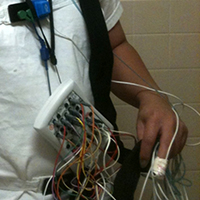Role of esophageal manometry in polysomnography of patients with chronic respiratory failure

Submitted: December 29, 2020
Accepted: May 15, 2021
Published: July 22, 2021
Accepted: May 15, 2021
Abstract Views: 4674
PDF: 599
Publisher's note
All claims expressed in this article are solely those of the authors and do not necessarily represent those of their affiliated organizations, or those of the publisher, the editors and the reviewers. Any product that may be evaluated in this article or claim that may be made by its manufacturer is not guaranteed or endorsed by the publisher.
All claims expressed in this article are solely those of the authors and do not necessarily represent those of their affiliated organizations, or those of the publisher, the editors and the reviewers. Any product that may be evaluated in this article or claim that may be made by its manufacturer is not guaranteed or endorsed by the publisher.
Similar Articles
- Massimiliano Polastri, Lara Pisani, Andrea Dell'Amore, Stefano Nava, Revolving door respiratory patients: A rehabilitative perspective , Monaldi Archives for Chest Disease: Vol. 87 No. 3 (2017)
- Michele Vitacca, Luca Barbano, Daniele Colombo, Olivia Leoni, Enrico Guffanti, Prevalence and variability of use of home mechanical ventilators, positive airway pressure and oxygen devices in the Lombardy region, Italy , Monaldi Archives for Chest Disease: Vol. 88 No. 1 (2018)
- A.G. Corsico, S. Villani, M.C. Zoia, R. Niniano, E. Ansaldo, G. Cervio, P.M. Quaresima, E. Gatto, E. Crippa, A. Marinoni, A. Foresi, E. Pozzi, I. Cerveri, Chronic productive cough in young adults is very often due to chronic rhino-sinusitis , Monaldi Archives for Chest Disease: Vol. 67 No. 2 (2007): Pulmonary series
- Muhammad Ijaz, Muhammad Jaffar Khan, Jawad Khan, . Usama, Association of clinical characteristics of patients presenting with influenza like illness or severe acute respiratory illness with development of acute respiratory distress syndrome , Monaldi Archives for Chest Disease: Vol. 87 No. 1 (2017)
- G. Caramori, M. Fabbri, D. Paioli, F. Falcone, C. Severino, G. Felisatti, O. Arar, I.M. Adcock, K. Fan Chung, P.J. Barnes, A. Ciaccia, A. Papi, Asthma is not a common cause of severe chronic respiratory failure in non-smokers: ALOT study , Monaldi Archives for Chest Disease: Vol. 63 No. 2 (2005): Pulmonary series
- S. Bertini, M. Picariello, M. Gorini, T. Renda, A. Augustynen, G. Villella, G. Misuri, N.M. Maluccio, R. Ginanni, D. Tozzi, A. Corrado, Telemonitoring in chronic ventilatory failure: a new model of survellaince, a pilot study , Monaldi Archives for Chest Disease: Vol. 77 No. 2 (2012): Pulmonary series
- L. Barbano, E. Bertella, M. Vitacca, Episodic medical home interventions in severe bedridden Chronic Respiratory Failure patients: a 4 year retrospective study , Monaldi Archives for Chest Disease: Vol. 71 No. 3 (2009): Pulmonary series
- Bruno Bordoni, Fabiola Marelli, Bruno Morabito, Beatrice Sacconi, Depression, anxiety and chronic pain in patients with chronic obstructive pulmonary disease: the influence of breath , Monaldi Archives for Chest Disease: Vol. 87 No. 1 (2017)
- P. Trerotoli, N. Bartolomeo, A.M. Moretti, Hospitalisation for COPD in Puglia: the role of hospital discharge database to estimate prevalence and incidence , Monaldi Archives for Chest Disease: Vol. 69 No. 3 (2008): Pulmonary series
- P. Carratù, G. Karageorgiou, P. Bonfitto, G. Di Gioia, D. Lacedonia, M.P. Foschino Barbaro, O. Resta, Long term evaluation of mental fatigue by Maastricht Questionnaire in patients with OSAS treated with CPAP , Monaldi Archives for Chest Disease: Vol. 67 No. 1 (2007): Pulmonary series
You may also start an advanced similarity search for this article.

 https://doi.org/10.4081/monaldi.2021.1756
https://doi.org/10.4081/monaldi.2021.1756





